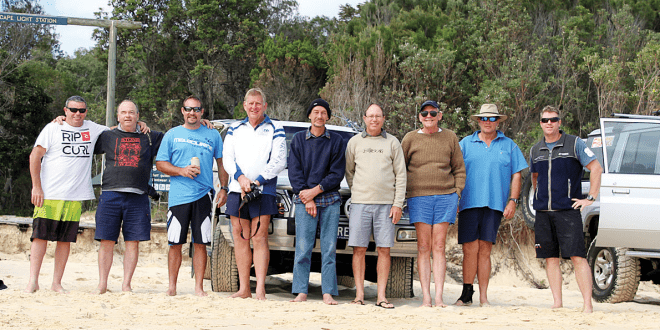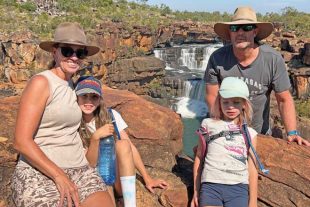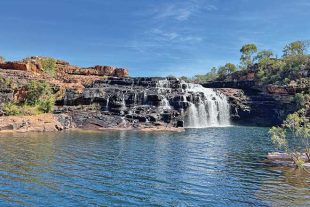WOW, what a week I recently had on Fraser Island with eight mates.
I am not sure whether it’s the isolation or extreme contrast between sheer breathtaking beauty and ultra-challenging conditions but Fraser Island will always be a magical destination for me.
I have many fond memories of the massive sand island (which I have touched on in my editorial this month) and the challenge of getting there still makes it a real adventure.
Bill Corten has covered a bit of the trip up the island and the fishing, so I want to go into a little more detail on the four-wheel-driving side of things.
Preparation is the key to a successful 4WD adventure on Fraser Island.
This is particularly so when towing large boats.
In this article I’ll cover some general 4WDing and beach towing tips when heading to Fraser.
Our annual pilgrimage this year included three 4WDs towing boats. These were a Lexus V8 petrol – 575 CruiseCraft, 200 Series V8 turbo diesel – 685 CruiseCraft, and Colorado 2.8L turbo diesel – 6.7 Performance plate alloy boat, as well as a recovery vehicle – 76 Series V8 turbo diesel.
While all capable 4WDs in their own right, adding a large boat to the back certainly changes the stakes.
Last year the Lexus and 200 Series had relatively incident-free trips up and back, so it was the addition of the Colorado and large plate boat that was going to make it interesting.
I did have some initial concerns about the Colorado and how it would tow nearly three tons of boat and trailer up the beach.
The Colorado had been lifted slightly, which gave it a nice level ride but the hitch point was still a little low. Thankfully the trailer was ultra-impressive, with large wheels and excellent clearance. Either way it was going to be interesting, especially with initial reports on beach conditions.
These days you can get beach reports online, so you have a good idea what conditions you will be facing before heading off.
We also try to speak to the owner or letting agent of the house where we stay to get a last minute report on conditions.
This year we knew it was going to be a challenge [/one_half_last]with lots of exposed coffee rock to negotiate. In fact the beach (or lack of beach) was in the worst condition I have ever seen it. The low pressure systems that hit the coast this year, combined with large swells have really left their mark and it is noticeable from the bottom end of the island all the way to Sandy Cape.
Large sand cliffs run most of the length of the island and the flat beach means travelling on or around the low tide is a must.
In addition, massive expanses of exposed coffee rock necessitate traversing the inland tracks rather than the beach.Just another challenge to overcome, but that’s all part of the adventure.
The trek from Hook Point to Indian Head is about 100km and while most of it is flat beach there are two main ar-eas you need to address, namely Poyungan Rocks and Happy Valley.
We had hoped to get around the rocks at Poyungan, but found there was not enough beach exposed between the rock and the surf to risk running the gauntlet, so the decision was made to take the high ground.
In preparation for the conditions, we had packed several planks of timber to aid in crossing the rocks. This combined with the use of in-car and hand-held radios enabled our drivers to know exactly where to go.
Having this clear communication definitely aids when 4WDing, especially in tricky situations.
This is amplified when towing, as sometimes it is impossible to see where your trailer wheels are going.
While at first the rock looked almost impassable, slow and steady was the go with the vehicles in low range.
Something I must point out is that all vehicles and trailers had their tyre pressures lowered at Inskip Point.
Most of the tow vehicles and trailers went down to around 18psi and I dropped the 76 Series to around 24psi.
As you can travel along the beach at 80km/h, I don’t like going too low unless I really have to. I also think that keeping a little more pressure helps eliminate pinching of the tyre wall or rolling a bead as you travel over the rocks.
There had been a bit of recent rain followed by a few showers that morning, so my gut feeling was that the sand would be a little firmer, allowing me to keep slightly more pressure in the tyres.
Another interesting thing was the absence of washouts. There were plenty of small freshwater streams running back to the surf, but most had little or no embankment to go over. I’m not sure if this was a result of the beach being washed away or not.
At present Happy Valley is totally impassable on the beach; you have to take the inland road. Obviously bottlenecks like these can take time to negotiate, especially if you have a long train of vehicles heading in one direction.
There are some passing points on the track but you need to show a little patience, which is something I think a few of the tour bus operators lacked. This was not only my opinion but the general consensus over the radios as well. It is pointless being in a rush in these situations. All you can do is sit back and relax, which is what most people did. Actually at times we had quite a few people watching our cars and boats negotiate the rocks and the general feedback was from people wondering how we got the big boat up there. It’s what we do each year, but it shows that if you are prepared, you can get through most situations.
Other challenges you are likely to face when towing a boat to Orchid Beach are the track around Indian Head, getting onto the boarded track at the Champagne Pools, and the oneway track over to Orchid Beach itself, as well as beach launching.
Next month I’ll continue the adventure, going into a bit more detail about the aforementioned challenges, recovery gear and how to use it, as well as tandem tows, beach launching and our trip to the Cape.
I am not sure whether it’s the isolation or extreme contrast between sheer breathtaking beauty and ultra-challenging conditions but Fraser Island will always be a magical destination for me.
I have many fond memories of the massive sand island (which I have touched on in my editorial this month) and the challenge of getting there still makes it a real adventure.
Bill Corten has covered a bit of the trip up the island and the fishing, so I want to go into a little more detail on the four-wheel-driving side of things.
Preparation is the key to a successful 4WD adventure on Fraser Island.
This is particularly so when towing large boats.
In this article I’ll cover some general 4WDing and beach towing tips when heading to Fraser.
Our annual pilgrimage this year included three 4WDs towing boats. These were a Lexus V8 petrol – 575 CruiseCraft, 200 Series V8 turbo diesel – 685 CruiseCraft, and Colorado 2.8L turbo diesel – 6.7 Performance plate alloy boat, as well as a recovery vehicle – 76 Series V8 turbo diesel.
While all capable 4WDs in their own right, adding a large boat to the back certainly changes the stakes.
Last year the Lexus and 200 Series had relatively incident-free trips up and back, so it was the addition of the Colorado and large plate boat that was going to make it interesting.
I did have some initial concerns about the Colorado and how it would tow nearly three tons of boat and trailer up the beach.
The Colorado had been lifted slightly, which gave it a nice level ride but the hitch point was still a little low. Thankfully the trailer was ultra-impressive, with large wheels and excellent clearance. Either way it was going to be interesting, especially with initial reports on beach conditions.
These days you can get beach reports online, so you have a good idea what conditions you will be facing before heading off.
We also try to speak to the owner or letting agent of the house where we stay to get a last minute report on conditions.
This year we knew it was going to be a challenge [/one_half_last]with lots of exposed coffee rock to negotiate. In fact the beach (or lack of beach) was in the worst condition I have ever seen it. The low pressure systems that hit the coast this year, combined with large swells have really left their mark and it is noticeable from the bottom end of the island all the way to Sandy Cape.
Large sand cliffs run most of the length of the island and the flat beach means travelling on or around the low tide is a must.
In addition, massive expanses of exposed coffee rock necessitate traversing the inland tracks rather than the beach.Just another challenge to overcome, but that’s all part of the adventure.
The trek from Hook Point to Indian Head is about 100km and while most of it is flat beach there are two main ar-eas you need to address, namely Poyungan Rocks and Happy Valley.
We had hoped to get around the rocks at Poyungan, but found there was not enough beach exposed between the rock and the surf to risk running the gauntlet, so the decision was made to take the high ground.
In preparation for the conditions, we had packed several planks of timber to aid in crossing the rocks. This combined with the use of in-car and hand-held radios enabled our drivers to know exactly where to go.
Having this clear communication definitely aids when 4WDing, especially in tricky situations.
This is amplified when towing, as sometimes it is impossible to see where your trailer wheels are going.
While at first the rock looked almost impassable, slow and steady was the go with the vehicles in low range.
Something I must point out is that all vehicles and trailers had their tyre pressures lowered at Inskip Point.
Most of the tow vehicles and trailers went down to around 18psi and I dropped the 76 Series to around 24psi.
As you can travel along the beach at 80km/h, I don’t like going too low unless I really have to. I also think that keeping a little more pressure helps eliminate pinching of the tyre wall or rolling a bead as you travel over the rocks.
There had been a bit of recent rain followed by a few showers that morning, so my gut feeling was that the sand would be a little firmer, allowing me to keep slightly more pressure in the tyres.
Another interesting thing was the absence of washouts. There were plenty of small freshwater streams running back to the surf, but most had little or no embankment to go over. I’m not sure if this was a result of the beach being washed away or not.
At present Happy Valley is totally impassable on the beach; you have to take the inland road. Obviously bottlenecks like these can take time to negotiate, especially if you have a long train of vehicles heading in one direction.
There are some passing points on the track but you need to show a little patience, which is something I think a few of the tour bus operators lacked. This was not only my opinion but the general consensus over the radios as well. It is pointless being in a rush in these situations. All you can do is sit back and relax, which is what most people did. Actually at times we had quite a few people watching our cars and boats negotiate the rocks and the general feedback was from people wondering how we got the big boat up there. It’s what we do each year, but it shows that if you are prepared, you can get through most situations.
Other challenges you are likely to face when towing a boat to Orchid Beach are the track around Indian Head, getting onto the boarded track at the Champagne Pools, and the oneway track over to Orchid Beach itself, as well as beach launching.
Next month I’ll continue the adventure, going into a bit more detail about the aforementioned challenges, recovery gear and how to use it, as well as tandem tows, beach launching and our trip to the Cape.
I look forward to talking to you again next month.
Ben Collins
Please comment below.
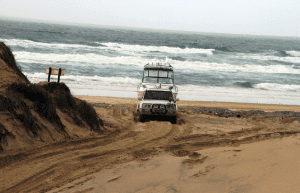
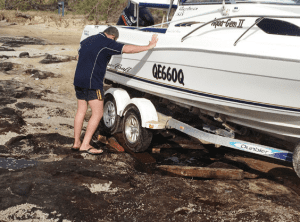
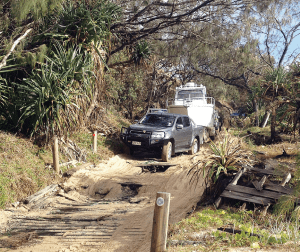
 Bush ‘n Beach Fishing Magazine Location reports & tips for fishing, boating, camping, kayaking, 4WDing in Queensland and Northern NSW
Bush ‘n Beach Fishing Magazine Location reports & tips for fishing, boating, camping, kayaking, 4WDing in Queensland and Northern NSW

